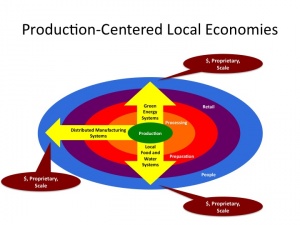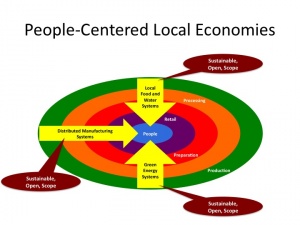Product-Centered Local Economy vs People-Centered Local Economy
Product-centered economic development

Steve Bosserman writes:
"For some, a local economy is production-centered as represented in the graphic above. In this model, production is the starting point in the center. Examples include goat cheese (thanks to Abbe Turner and Lucky Penny Creamery for hosting our session!), lambs for meat, and CSAs. Output, whether food, water, energy, fuel, or housing and clothing, targets specific market niches among people in the outer ring (the arrows point outward). Output has the option of passing through the steps of processing, preparation, and retail along the way. The system is designed according to three organizing principles: money rules, keep your business to yourself (the brutal free enterprise system at work), and scale up at every opportunity to extract a competitive advantage."
People-centered economic development
Steve Bosserman writes:
"The alternative local economy is people-centered, as depicted in the graphic above. In this instance the system starts with people as a market block in the center who, collectively, draw the output of the various systems to them based on satisfying a critical need in the most affordable, convenient, healthy, safe, and secure manner. In other words, people in a local area become the integrative agents who define the system and bring the elements together on their terms. This can be as simple as serving a plate of food from local sources, or as complex as manufactured components and assemblies in a major advanced energy installation made in local distributed manufacturing operations.

...
To continue, this concentration of people can be residents in a neighborhood or community, employees at their workplace, students, faculty, and administration at a school or university, or staff and clientele at a medical center. The point of consumption is the most important because it is here that the person in the middle chooses to purchase from a local source based on affordability, convenience, healthiness, safety, and security. Once that decision is made, the balance of retail-to-preparation-to-processing-to-production flow is organized in support of the consumer (the arrows point inward). ... The organizing principles for the system are sustainability (resilience and persistence), openness (development and collaboration), and scope (diversity and variety).
...
The people-centered approach starts with the marketing premise that people, given a viable option to choose a healthier, safer, and more secure alternative without having to compromise affordability and convenience (and taste, in the case of food), will take it. Another premise is that A system designed with attention to sustainability, openness, and scope can deliver a viable option. An institution-based local food systems such as the Cleveland Clinic - City Fresh / Cleveland Botanical Garden, or Planet Ohio - Ohio University are examples. This sets the stage for a business case presented by Steve Fortenberry and Goodness Grows to implement a Workforce Food Center concept, whereby a local food system is designed to serve several hundred employees of a large enterprise at great savings to the employer due to reduced health care costs through healthier food choices for the employees. Everyone wins. This business case will be loaded into the Ag-Bio Cluster community investment portfolio from which all can learn and benefit! "